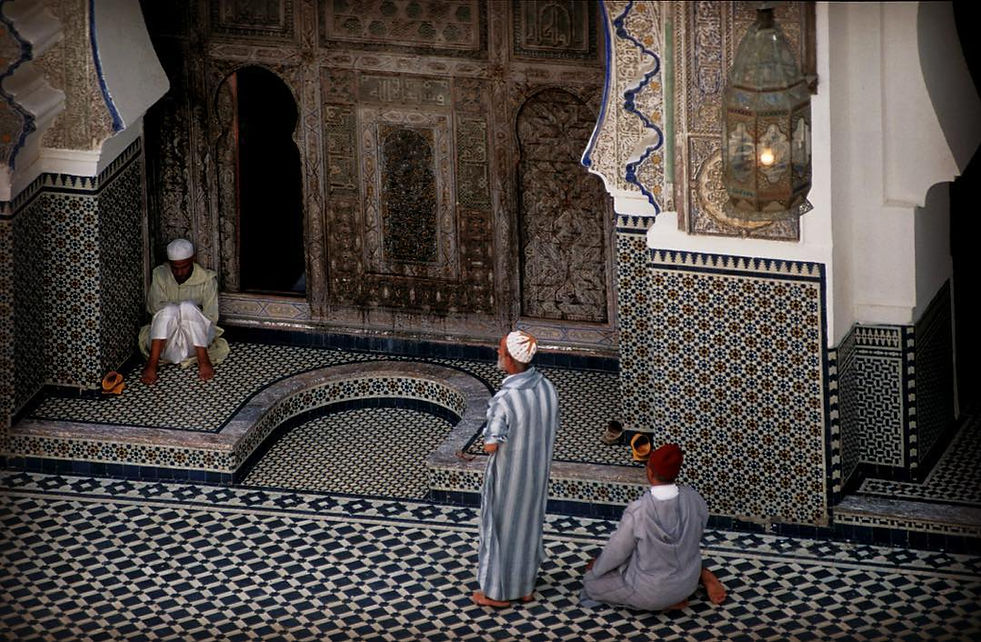Sur les terres oubliées des Petites Iles de la Sonde
Sur les terres oubliées des Petites Iles de la Sonde
La route impériale
Fès
On ne peut la parcourir qu’en remontant le temps, bien entendu, en partant du résultat final, Fès, Moulay Idriss, Meknès
– les villes impériales - , pour aller à la source du pouvoir originel, le Tafilalet et Sijilmassa, aussi culte que Tombouctou, la capitale mythique dissoute par les sables.
Tout a commencé au Maroc par l’arrivée d’un jeune prince venu d’Orient, après les « siècles obscurs » qui ont suivi le déclin de l’Empire romain, jusqu’à la conquête par Tarik qui va donner son nom au détroit entre les deux mondes qu’il va unifier : djebel Tarik, devenu Gibraltar. Idriss, personnage tout à fait réel, est nimbé de cette auréole de légende qui fait les grands destins. Puis l’histoire rebondit avec des princes venus du Tafilalet, issus comme lui de la proche famille du prophète.

Fès.
Vue du tombeau des Mérinides, au centre on voit se détacher le haut minaret de la mosquée Karaouyne.

Fès.
Palais royal de Fès

Fès, Bab Boujloud.
Avant une visite officielle on donne un petit coup de blush à cette ville sans égale qui resplendit depuis douze siècles.
La place est très grande et la muraille très haute. Deux hommes sont suspendus à cette grande courtine et je me demande encore comment ils ont peint les créneaux, si haut ! La partie réservée renforce l’abstraction de l’ensemble : quelque chose qui tient de la fresque, de l’invention d’une falaise.

Fès.
Les toits de la Karaouine, en longs sillons de tuiles vertes.L’une des plus célèbres mosquées de la ville, dans sa rigueur géométrique qui protège les trésors de la décoration intérieure d’une exceptionnelle richesse.

Fès.
Mosquée Karaouine, à l’heure des ablutions. Vue de la ruelle. Le petit-fils escorte son grand-père tout de blanc vêtu. Mais l’enfant porte une chemise canadienne qui contraste singulièrement avec la tenue traditionnelle de son aïeul, et reste songeur.

Fès.
La première cour de la Karaouine vue du toit de la médersa voisine El-Attarine, car on ne rentre pas dans les mosquées du Maroc (sauf celle de Casa, avec accompagnateur).Par bonheur, l’accès aux médersas, centres d’enseignement, est libre ; le regard aussi, même s’il se réduit.

Fès.
Une marchande de cierges devant le mausolée Moulay Idriss II.
Pendant des siècles on a dit « le royaume de Fès », pour la bonne raison que la ville double est vraiment un royaume en soi, dont tous les citoyens sont rois. Ce qui n’avait jamais simplifié la vie du pouvoir légal.

Fès. Les portes du Palais Royal

Fès.
Le souk des tanneurs.Cette fonction difficile et fatigante est réservée aux jeunes gens.


Fès, Medersa Bou Inania.

La route de la Soie à Fès, c’est d’abord ces rangées immaculées de fil qui viennent de prendre leur couleur. Le blanc de ces soyeux sillons domine les couleurs plus sourdes de la ville.

Et en voyant cet homme qui file, l’esprit perdu dans ses pensées, empreint d’une telle sérénité, j’ai immédiatement pensé à Gandhi, le vêtement en plus… Il use d’un matériel qui paraît élémentaire mais qui est parfaitement adapté à la fabrication d’un fil si ténu, dont on fait des étoffes si fines, qu’un vêtement entier peut être logé dans le tube intérieur d’une simple canne : quelques dixièmes de millimètre. Une substance sans épaisseur, un rêve.


C’est la suite de cette longue métamorphose qui transforme un cocon en vêtement d’apparat. Cette échoppe est un nuancier si complet que je n’ai pas résisté au plaisir d’acheter des fils de toutes les couleurs (j’ai compté neuf bleus différents…) enroulés sur de longues bobines renflées, des oeuvres d’art à part entière.
Un cauchemar de caméléon !

Quand le passé revisité télescope le présent vivant : ces jeunes femmes, fresque d’un salon du palais Jamaï dans sa version toute récente, rencontrent cette
mariée de Fès, dans sa tenue la plus authentique, et sa discrète accompagnatrice. Elles ont d’ailleurs plus l’apparence de Romaines que de houris, à enchanter le paradis. Mais l’heure, dans les deux cas, est à la fête.


Fès, la Zaouia Moulay Idriss II, le lieu saint de Fès. Les femmes viennent pour s'attribuer une part de la "baraka" de Moulay Idriss, souvent pour une grossesse.

Fès, La partie réservée pour la prière des femmes à la mosquée Karaouine. Vrai lieu d'échange.

Fès, près de la Zaouia Moulay Idriss II

Fès, le Talha.
Dans cette ruelle parfumée, si animée, une évidence : ces pastèques rangées comme des obus d’artillerie lourde ou des bombes lustrées. C’est à la fois l’abondance des jardins du Saïs et le mystère d’une forme que l’on peut interpréter à sa guise. Le vendeur est bienveillant, courtois, devant le photographe qui ne veut pas gêner mais qui ne peut résister : il a dû en voir d’autres !

De l’or dans une rue de la médina de Fès ? Non, simplement le jeu des reflets des feuilles de cuivre que le dinandier déroule à même le sol. Puis il va les découper au gabarit des plateaux à ciseler. Dans le passage désert, c’est une illumination soudaine venue de nulle part.

Fès, la place des chaudronniers

Fès, le quartier des chaudronniers et des cuivres

Fès. Bab Bou Jloud, et sa célèbre couleur violette patinée par le temps, la plus célèbre des portes de la ville impériale, la plus fréquentée. C’est la clé de la ville, son accès le plus direct.






